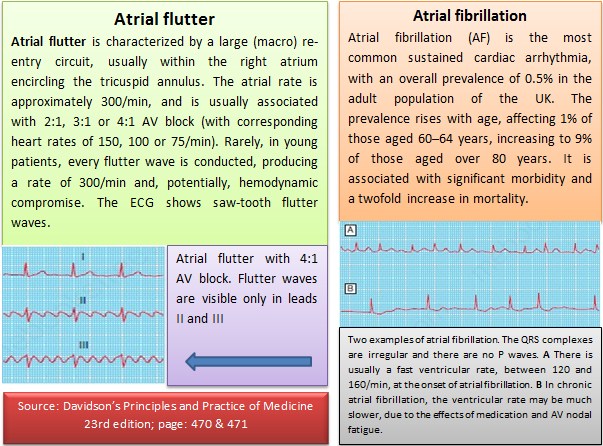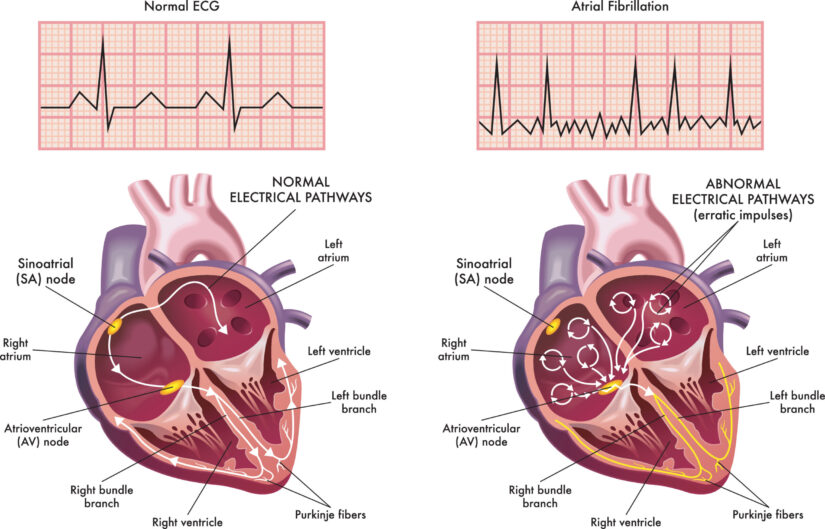
If underlying cardiac disease like CHF is present, the treatment will also be directed towards its treatment, along with stabilizing the heart rhythm. Electrical shock therapy may be used to normalize the rhythm is some cases. If the fibrillation is a chronic problem (more than four months), the success rate drops accordingly and problem recurrence is common in these cases. If no underlying disease is found to be present, the treatment will be directed towards normalizing the rhythm of heart and getting the sinoatrial node back into sync with the atrioventricular node (AV) node. If the heart is beating too rapidly, your dog will be treated medically for the rhythm to be slowed down. Your veterinarian will first diagnose the level of flutter or fibrillation your dog is experiencing, and whether there is an underlying disease of the heart, such as CHF, that is responsible for the atrial arrhythmia. Additional diagnostic tools include echocardiography (ECG), X-ray imaging, and color Doppler to help in characterizing the type and severity of any underlying heart disease. It is possible that the results of these tests may not reveal much information related to this disease, but they may be helpful for accessing an overall picture of your dog's health and reveal other diseases, if present. Laboratory tests include a complete blood profile, with a biochemical profile, complete blood count, and urinalysis. As a sequel congestive heart failure (CHF)Īfter taking a detailed history from you, including your dog's background health history and onset of symptoms, your veterinarian will perform a complete physical examination.Digoxin toxicity (drug commonly used to treat various heart diseases).Chronic disease of the heart involving the valves.Following are few of the symptoms related to atrial fibrillation.

The symptoms generally relate to an underlying disease like congestive heart failure (CHF). Arrhythmia lasts for more than 48 hours, only responds to treatment.Periodic, recurrent episodes, which last for a short period of time (less than seven days), with the heart returning to its normal rhythm on its own.Severe underlying cardiac disease like CHF is usually involved.No underlying cardiac disease involved – cause not identified.Symptoms and TypesĪtrial fibrillation is categorized by relevance, including: On an electrocardiogram (ECG), which measures the electrical activity of the heart, a distinct pattern can be differentiated in atrial fibrillation and atrial flutter. Atrial fibrillation can occur with or without underlying heart disease. In atrial fibrillation the atria beat chaotically, resulting in irregular rhythms of the ventricle as well. In atrial flutter there is a premature electrical impulse that arises in the atria, resulting in a faster than normal heart rate, either regular or irregular in frequency, whereas in atrial fibrillation there is quivering type of contraction of the heart muscles, resulting in a rapid and abnormally paced heart rhythm, also referred to as arrhythmia. Atrial flutter is often a precursor to atrial fibrillation.

Both conditions refer to a rhythm problem that originates in the upper chambers of the heart, that is, the atria.

In both atrial fibrillation and atrial flutter this rhythm is disturbed and synchronization is lost between the atria and ventricles. The heart works with exceptional synchronization between the various atrial and ventricular structures, resulting in a consistent rhythmic pattern.

The valve between the right atrium and right ventricle is called the tricuspid valve, where the valve between the left atrium and left ventricle is called the mitral valve. Valves are provided between each atrial and ventricular pair, each on the left and right side. The two top chambers are called the atria (single: atrium) whereas the bottom chambers are called the ventricles. Atrial Fibrillation and Atrial Flutter in DogsĪ dog's heart is divided into four chambers.


 0 kommentar(er)
0 kommentar(er)
